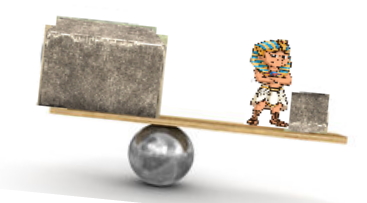日志
How the Stone Blocks of the Egyptian Pyramids Were Lifted?
热度 1 ||
Some person asserted that the Egyptian pyramids were nothing miraculous. One hundred thousand farmers in a county in China have built a reservoir on their shoulders. The amount of earth and stone is more than that of the pyramids. This comparison fails to appreciate the difficulty of building the pyramids. One can carry 50 kilograms of soil at a time to the height of one hundred meters quite easily. A stone block on the Egyptian pyramids may weigh more than a dozen tons in a single regular piece. How did the Egyptians raise such a large stone to a height of over a hundred meters?
The traditional widsom is that the Egyptians built a long ramp and the stones were dragged up the slope with ropes. Let's calculate the amount of work required to build such a ramp and the manpower required to drag the stone. Assuming a slope of ten degrees and a height of 100 meters, the length of the ramp is 100/sin (10 degrees) ~ 570 meters, and pulling 10 tons of stone requires 10*sin (10 degrees) ~ 1.7 tons of pulling force. A stone may be dragged halfway and the workers are out of breath and the rope may be about to break. Now, the thing wants to slide back down. This is arguably the most primitive brute force method. It requires continuous exertion of muscles.
Some time ago, I saw an engineer proposed a novel solution on the Internet. The person also wrote a book on this subject. The idea is to use the buoyancy of water. Tie leather air bags on the stone, then create a pool to float the stone up. But this plan has a major problem. The pressure at the bottom of a 100 meters deep pool is 10 atmospheric pressures. To resist such a large pressure without walls of the pool bursting, the pool must placed in the middle of the pyramid. Still, the pressure on the water locks is huge. Assuming that the minimum cross section of 1x1 meters, the force of pressure on the water lock is 100 tons. Under such forces, the engineering required to keep the locks water tight and operate with ease is challenging even today.
Someone suggested that the stones could be lifted up with gears, pulleys, etc. But pulleys may not have been invented at that time. The use of pulleys requires ropes and racks that can withstand the weight of the stones. This was difficult to do 4000 years ago.
So, how do we do it at low cost and high efficiency? Looking at the pyramids built by the Egyptians 4000 years ago, can it be reverse-engineered? I thought about it and found the following solution.
Use a "seesaw" to lift the stone up, then turn it horizontally, to raise it up to a higher level step, where another "seesaw" will lift it to yet another level. In this way, it is enough to lift the stone one level at a time. The seesaw material can be relatively strong wood. The fulcrum can be made of two or more balls (or cylinders) framed on a line, so that the seesaw can move up and down about a horizontal axis and rotate in the horizontal plane around a vertical axis. Put some oil on the balls for lubrication, a few workers ought to be able operate such a device. It is a simple repetition of loading, seesaw lifting, seesaw turning, and unloading rocks, one step at a time. One may even directly unload the lifted stone on loading side of the higher level "seesaw", in an assembly line fashion. Comparing to the brute force dragging method, this turning seesaw approach is quite efficient and pleasant. The schematic diagram is as follows (for better balance, two or more balls (or cylinders) can be used).
If the Egyptians adopted this scheme, it would have been easy for them to discover that if the loading end of the seesaw is shorter, smaller weight is needed at the counter balancing side for the lifting operation. How to achieve higher efficiency is a problem that can be continuously improved in practice. The adjustment of weights at the counter-balancing end should be minimized. Ideally, it should operate with a few people stand on it and then the seesaw can be turned horizontally by another person, without adding and removing too much counter weights.
As far as I know, the above pyramid stone lifting method may be the most feasible, lowest cost, and most efficient solution presently conceived. I hope to it be verified by experimentation and confirmed by archaeology.
全部作者的其他最新日志
- • 太阳系模拟网站
- • 中国促进AI民主化
- • 拜登支持乌克兰反侵略战争的经济效益
- • 什么是多客(Docker)
- • 服务器迁徙计记
- • 感恩节快乐!








